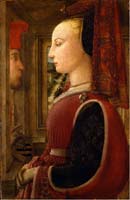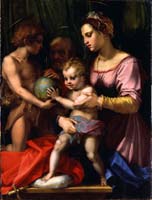Two Drama Kings Take on a Master
Paul Giamatti and Alfred Molina read "Fra Lippo Lippi" and "My Last Duchess."
BY The Editors
Introduction
In some of Browning’s dramatic monologues, major Italian Renaissance painters talk about sticky situations and obsess about painting. They typically address a silent listener who for one reason or another blames the painter for a bad situation. In the audio recordings below, you can hear why these poems rival Shakespeare's character studies.
In some of the recordings, critics and actors explain and read the poems. In others, an art critic explains the paintings by the actual artists who appear as characters in the monologues.
1. Paul Giamatti reads “Fra Lippo Lippi”
2. W.S. Di Piero explains “Fra Lippo Lippi” with excerpts read by Paul Giamatti
3. Alfredo Molina reads “My Last Duchess”
4. W.S. Di Piero explains “Andrea del Sarto” with excerpts read by Dion Flynn
5. W.S. Di Piero explains a painting by Fra Lippo Lippi
6. W.S. Di Piero explains a painting by Andrea del Sarto
7. W.S. Di Piero explains a painting by Fra Angelico
“Fra Lippo Lippi”
By Robert Browning read by actor Paul Giamatti.
Dressed like a monk and caught by the police in the red light district after hours, Fra Lippo Lippi tells his life story to get out of the jam.
Read the poem
![]()
Audio Reading Guide to “Fra Lippo Lippi”
Narrated by W.S. Di Piero with excerpts from the poem read by Paul Giamatti.
Read the poem
![]()
“My Last Duchess”
By Robert Browning read by actor Alfredo Molina.
In “My Last Duchess,” the duke of Ferrara shows off his art collection to the representative of a nobleman to whose daughter the duke is engaged. The centerpiece of his collection is a portrait of his recently deceased wife, whom the duke has had murdered because of her supposedly indiscriminate attentions.
Read the poem
![]()
Audio Reading Guide to “Andrea del Sarto”
Narrated by W.S. Di Piero with excerpts from the poem read by Dion Flynn.
“Andrea del Sarto” is spoken by the 16th-century artist who was described by one of his contemporaries as “the faultless painter.” In this monologue, Andrea del Sarto attempts to have a “relationship talk” with his wife Lucrezia: “A few years earlier, she persuaded him to return from the Court of France where he’d been invited and won acclaim and prosperity. Now he fears his return may have cost him the supreme fame of a Michelangelo or Raphael."
Read the poem
![]()
 Audio Guide to the painting Portrait of a Man and Woman at a Casement (1440) by Fra Lippo Lippi
Audio Guide to the painting Portrait of a Man and Woman at a Casement (1440) by Fra Lippo Lippi
Narrated by W.S. Di Piero.
This opulent portrait of a man and a woman who appear devoted to one another is an example of Fra Lippo Lippi's attentiveness to sensual beauty. Visit the Met to view the painting.
![]()
Portrait of a Woman and a Man at a Casement, ca. 1440
Tempera on wood; 25 1/4 x 16 1/2 in. (64.1 x 41.9 cm)
The Metropolitan Museum of Art, Marquand Collection, Gift of Henry G. Marquand, 1889 (89.15.19)
 Audio Guide to the painting Holy Family by Andrea del Sarto
Audio Guide to the painting Holy Family by Andrea del Sarto
Narrated by W.S. Di Piero.
The great rivalry in Italian Renaissance painting was between Fra Angelico and Andrea del Sarto. W.S. Di Piero explains why this painting, in which Saint John the Baptist hands a globe to the Christ child, exemplifies the charm of del Sarto’s paintings, which Fra Angelico's often lacked. Visit the Met to view the painting.
The Holy Family with the Infant Saint John the Baptist, ca. 1530
Oil on wood; 53 1/2 x 39 5/8 in. (135.9 x 100.6 cm)
The Metropolitan Museum of Art, Maria DeWitt Jesup Fund, 1922 (22.75)
 Audio Guide to the painting The Last Judgment: Paradise by Fra Angelico
Audio Guide to the painting The Last Judgment: Paradise by Fra Angelico
Narrated by W.S. Di Piero.
This portion of Fra Angelico's triptych, The Last Judgment, shows a procession of souls into heaven. The swaying angels dance toward heaven while down in the right corner of the third panel (not shown) crouch miserable creatures, brutalizing each other. As W.S. Di Piero explains, Angelico made these demons an ugliness that "menaces the beauty of God’s creation, a corruption that claws at vulnerable but divinely authored human souls."
BIOGRAPHIES
Robert Browning (1812-1889) was born in Camberwell, England, and his education mostly took place among his father’s 6,000-book library. As a writer, Browning was regarded as a failure for many years, living in the shadow of his wife Elizabeth Barrett Browning. However, late in life Browning’s brilliant use of dramatic monologue made him a literary icon. Today, his most widely read work is Men and Women, a collection of dramatic monologues dedicated to his wife.
Fra Angelico (1400-55) is popularly viewed as an inspired saint and monk, a belief that Pope John Paul II solidified when he beatified him in 1984. In fact, he was a highly skilled artist engaged in the aesthetic debates in contemporary Florentine art. He lived for most of his life in the S. Domenico in Fiesole, where he became Prior in 1450. His most famous works, though, were painted at S. Marco in Florence, a Sylvestrine monastery that was taken over by his order in 1436. He and his assistants painted about 50 frescos in the friary (c.1438-45) that are at once the expression of and a guide to the spiritual life of the community. Many of the frescos are in the friars' cells and were intended as aids to devotion. With their immaculate coloring, their economy in drawing and composition, and their freedom from the accidents of time and place, they attain a sense of blissful serenity.
Paul Giamatti was born in New York City to A. Bartlett Giamatti, a Yale University professor who later became president of the university and commissioner of Major League Baseball. He appeared in a number of supporting roles in big-budget movies such as The Truman Show, Saving Private Ryan, and The Negotiator and has also appeared in more major roles in Big Momma's House, Planet of the Apes, and Big Fat Liar. Giamatti's most acclaimed performances include lead roles in American Splendor and Sideways. He recently won a Screen Actors Guild award and received an Oscar nomination for his role in 2005's Cinderella Man.
Alfred Molina has over 50 film, television, and theatre productions to his credit. Most recently, he has played Diego Rivera in Frida, himself in Coffee and Cigarettes, and the villain, Doc Ock, in Spiderman II. In his next film, he plays opposite Tom Hanks in Ron Howard’s The Da Vinci Code.
W.S. Di Piero is the author of numerous volumes of poetry and essays. His latest book of poems, Brother Fire, appeared in 2004 from Knopf, which will publish his New and Selected Poems in early 2007. He writes frequently on the visual arts for Threepenny Review and is the art columnist for the San Diego Reader. He lives in San Francisco.
The Fra Angelico exhibition ran from October 26, 2005, through January 29, 2006, at the Metropolitan Museum of Art.
The editorial staff of the Poetry Foundation. See the Poetry Foundation staff list and editorial team masthead.


